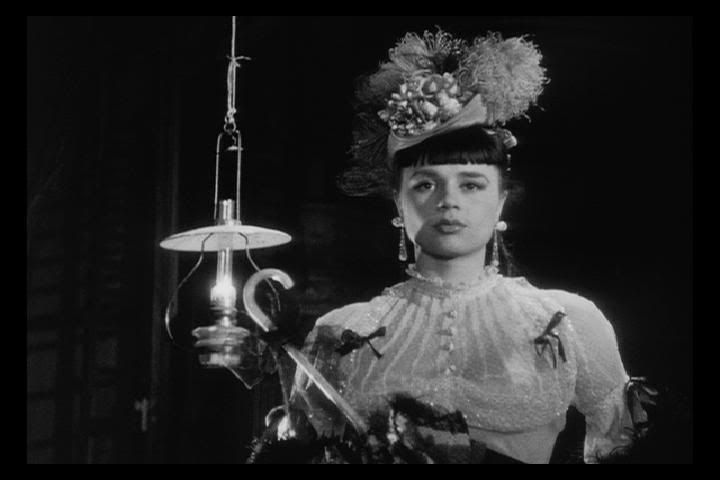
When Ingmar Bergman died earlier this year, there was a certain strain of criticism — most (in)famously presented by Jonathan Rosenbaum in the New York Times — that took the occasion to re-evaluate the famed director's art and importance. At the time, I found the timing unfortunate and the arguments unconvincing; Bergman has always been a director who has meant a great deal to me, and at least several of his films have to be counted among my personal canon. Looking back now, having just watched Sawdust and Tinsel, a key developmental work for Bergman and yet probably the weakest of the many films I've seen by him, I nevertheless remain more convinced than ever that Bergman is a cinematic great.
Let me explain. I have yet to explore much of Bergman's early career, and it's mainly some later milestones that have endeared him to me: Fanny and Alexander, Persona, The Silence, and even a few flawed but powerful works like Shame and Hour of the Wolf. Sawdust, the story of the bitter circus owner Albert (Åke Grönberg) and his unfaithful mistress Anne (Harriet Andersson), shares some similarities with these later works, and it's easy to see how Bergman got from here to the more fully realized films he'd be making just a few years later. The film's story is told in a blend of expressionism and neorealism, with the latter pointing back to Bergman's earliest dramas and the former pointing ahead to the direction his films would take from then on. The expressionistic sequences are often compelling, displaying the kind of visual sense and eye for composition within cinematic space that detractors like Rosenbaum are continually insisting is missing from Bergman's cinema.
In the film's most compelling image, when Anne goes to visit the local theater troupe after a fight with Albert, she's left on the abandoned stage after a rehearsal. As the theater goes dark, she's framed within a circle of light, all alone in a sea of black. Critics often point to Bergman's theatrical fascination as an inherent negative — something you'd never hear about, say, Fassbinder — but this scene makes it clear that even early on Bergman understood the difference between cinematic and theatrical space, and was able to combine them in interesting ways. In this sequence he creates an interplay between the theater and the cinema, framing Andersson first in what might be called theatrical space, with the camera at a distance showing the whole stage with her in its center (though even here he tweaks the theater by placing the camera backstage rather than in an audience's position). Then he cuts to a medium shot, with Andersson approaching the camera, slowly filling the frame, the close-up allowing her cold and determined expression to complicate the scene's emotions, in a sense contradicting the lost, confused sense communicated by the earlier distancing long shot. Both emotional sensations remain in the shot; just as the theatrical space is being contained and reshaped by the cinematic frame, the loneliness and isolation of the long shot is being subsumed by Anne's determination to control her life.
There's also a wonderful scene early on in the film in which one character relates the story of the clown Frost (Anders Ek), whose wife betrayed him by swimming nude with some soldiers from the local garrison. Frost's very public humiliation as he's forced to retrieve his wife in front of a laughing mob and carry her naked body away prefigures the story of Albert's problems with his mistress. Bergman presents the flashback in a washed-out, overexposed white that obliterates detail and gives the scene a haunting, mesmerizing quality. There is quite possibly no greater director of embarrassment than Bergman, and he perfectly captures the humiliation of Frost, cutting between tortured close-ups and wildly exaggerated crowd shots of the observers. The soundtrack is similarly suggestive, veering between an eerie stillness and the roar of cackling laughter. The scene becomes sheer torture as it goes along, as much a purely symbolic representation of primal emasculation as a recounting of a specific incident.
Unfortunately, such scenes are the exception rather than the rule in this film. Bergman's engagement with neorealist aesthetics is much less interesting than his more expressionistic mode of storytelling. And though Bergman is frequently accused of theatricality because of the overwrought performances he wrings out of his actors in his wildest scenes, it's in the more realistic segments of his work that theatricality more often has free rein. For me, Sawdust is dragged down by the prosaic quality of its story and the overly theatrical emphasis on lengthy dialogue scenes with little visual or intellectual interest. Everything that the film might have to say in Grönberg's blustering speeches was already said far better in that self-contained early scene depicting Frost's humiliation, and doing so primarily in visual terms rather than verbally. The narrative never progresses far beyond there, because Bergman has structured things so that Frost's story is meant to foreshadow Albert's. What it actually does is render the rest of the film redundant. There's some pleasure in Harriet Andersson's effortless sensuality, and in Anders Ek's drunken, spiteful performance as the broken clown Frost, but the emphasis on such theatrical, actorly elements is exactly what Bergman's critics latch onto in the first place. In this early film, at least, there's some justice to the complaints.
It may seem odd that I've chosen a Bergman film I don't really like that much to mount a defense of this great director. But what struck me, on watching Sawdust and Tinsel, was not only the number of things that didn't work, but just how much did work in spite of the many weaknesses. Even in this minor transitional film, Bergman was already displaying the foundations of a powerfully expressive visual style and a tendency to intertwine cinema and theater in ways that comment on and develop both. He will certainly be missed.







0Awesome Comments!